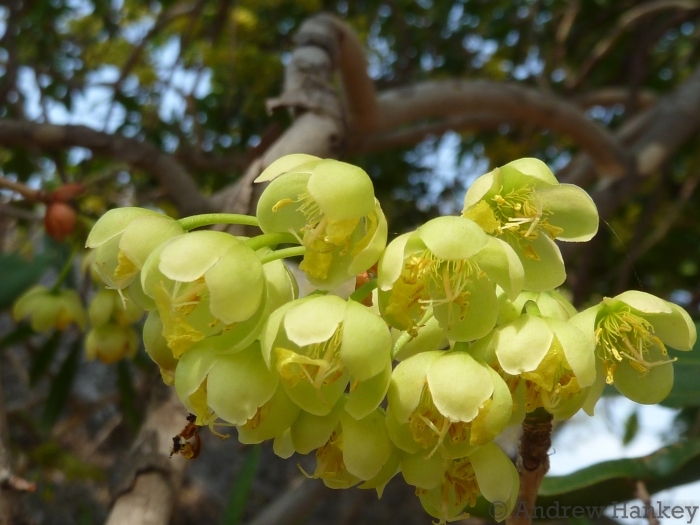Lekkerbreek
(Ochna pulchra)
Lekkerbreek (Ochna pulchra)
/
/

© Andrew Hankey
CC BY-SA 4.0
Image By:
© Andrew Hankey
Recorded By:
Copyright:
CC BY-SA 4.0
Copyright Notice:
Photo by: © Andrew Hankey | License Type: CC BY-SA 4.0 | License URL: http://creativecommons.org/licenses/by-sa/4.0/ | Uploader: andrew_hankey | Publisher: iNaturalist |

























Estimated Native Range
Summary
Ochna pulchra, commonly known as Lekkerbreek, is a small deciduous tree that can reach up to 16 feet in height. It is native to the savannas and open woodlands of southern Africa, specifically in regions such as the central Transvaal and northern Kruger National Park, and extends to Mozambique, Zimbabwe, Botswana, Angola, Zambia, and the Democratic Republic of the Congo. Ochna pulchra typically grows on deep sandy soils and rocky outcrops within its native range, where it is adapted to a seasonal climate with a distinct dry season.
The Lekkerbreek is notable for its distinctive peeling bark and the striking color transition of its foliage in spring, which ranges from light green to bright red. It produces lemon-yellow flowers that bloom in spring, adding a splash of color to the landscape. The flowers are followed by kidney-shaped drupe fruits that mature to a glossy black, providing visual interest. In cultivation, Ochna pulchra is valued for its ornamental bark, attractive foliage, and bright flowers. It is used in gardens and parks, often as a specimen tree. This species prefers full sun to part shade and requires well-drained soil. It is relatively drought-tolerant once established, making it suitable for xeriscaping or low-water landscapes. While it is generally low-maintenance, it can be susceptible to pests such as scale insects.CC BY-SA 4.0
The Lekkerbreek is notable for its distinctive peeling bark and the striking color transition of its foliage in spring, which ranges from light green to bright red. It produces lemon-yellow flowers that bloom in spring, adding a splash of color to the landscape. The flowers are followed by kidney-shaped drupe fruits that mature to a glossy black, providing visual interest. In cultivation, Ochna pulchra is valued for its ornamental bark, attractive foliage, and bright flowers. It is used in gardens and parks, often as a specimen tree. This species prefers full sun to part shade and requires well-drained soil. It is relatively drought-tolerant once established, making it suitable for xeriscaping or low-water landscapes. While it is generally low-maintenance, it can be susceptible to pests such as scale insects.CC BY-SA 4.0
Plant Description
- Plant Type: Shrub, Tree
- Height: 8-16 feet
- Width: 4-8 feet
- Growth Rate: Moderate
- Flower Color: Yellow
- Flowering Season: Spring
- Leaf Retention: Deciduous
Growth Requirements
- Sun: Full Sun, Part Shade
- Water: Low, Medium
- Drainage: Medium, Fast
Common Uses
Bird Garden, Drought Tolerant, Low Maintenance, Potted Plant, Showy Flowers
Natural Habitat
Native to savannas and open woodlands of southern Africa
Other Names
Common Names: Lekkerbreek, Bird’s Eye Bush, Fuku, Iselete, Kabandamite, Musesatshula, Mutombatongoshi, Nkasu
Scientific Names: , Ochna pulchra, Diporidium pulchrum, Diporidium pulchrum, Diporidium quangense, Ochna antunesii, Ochna antunesii, Ochna aschersoniana, Ochna brunnescens, Ochna brunnescens
GBIF Accepted Name: